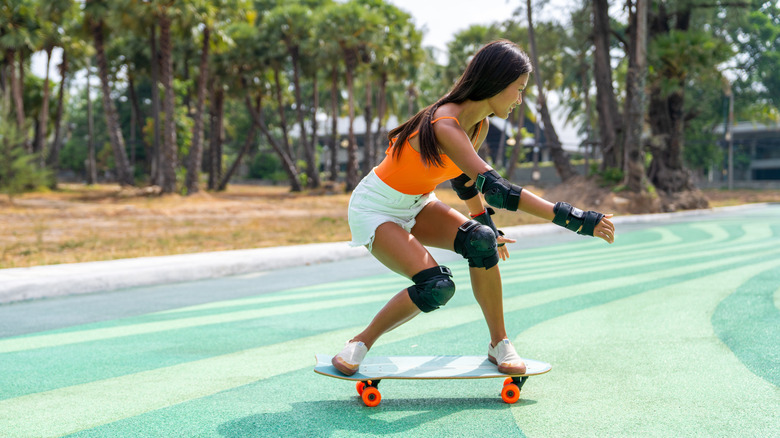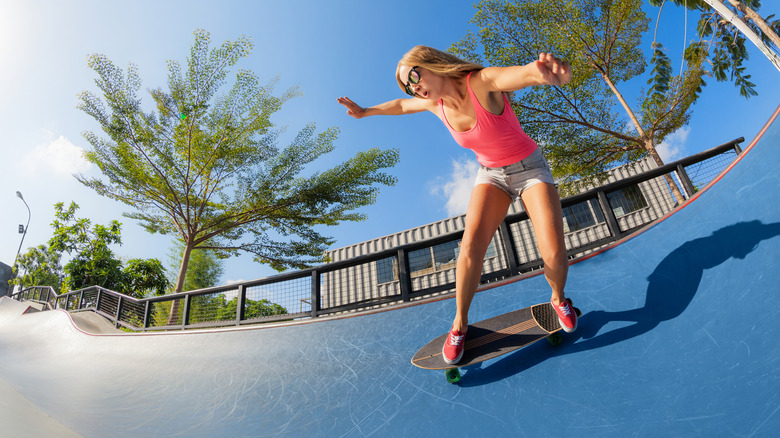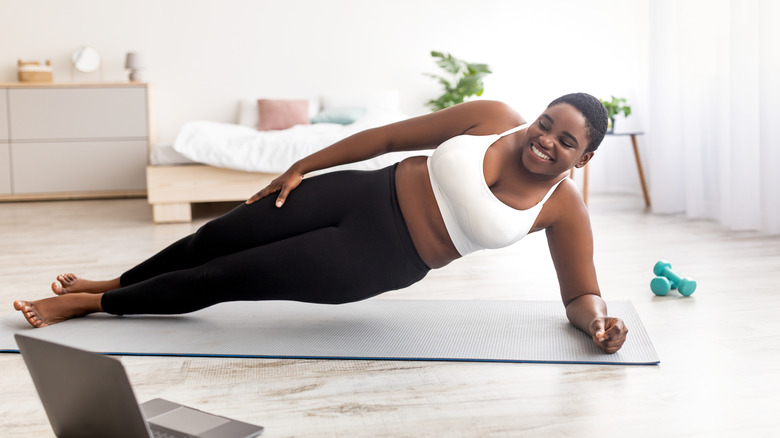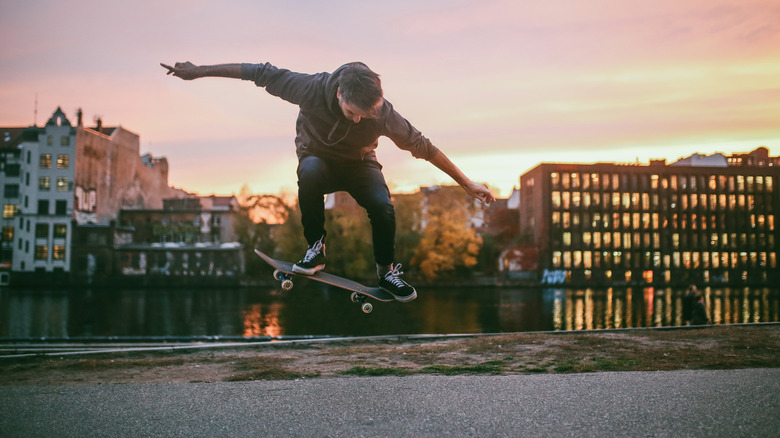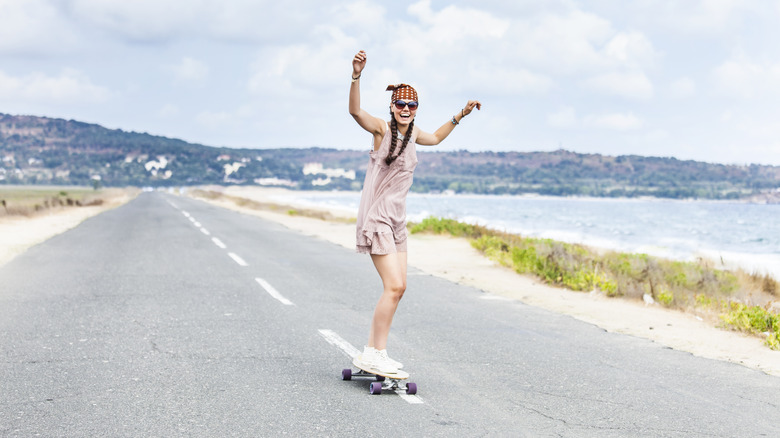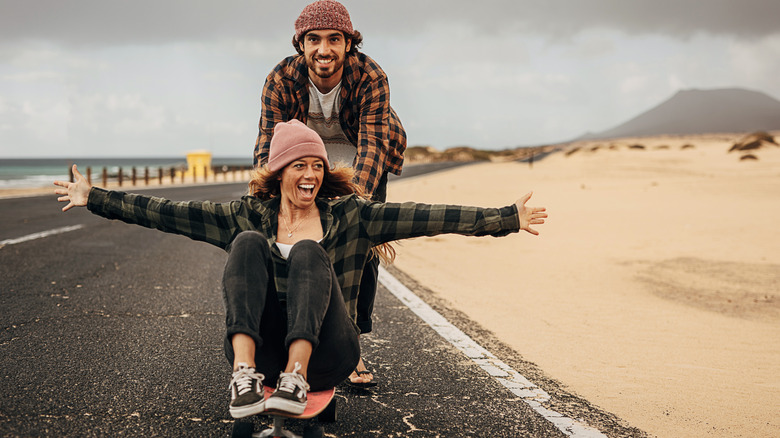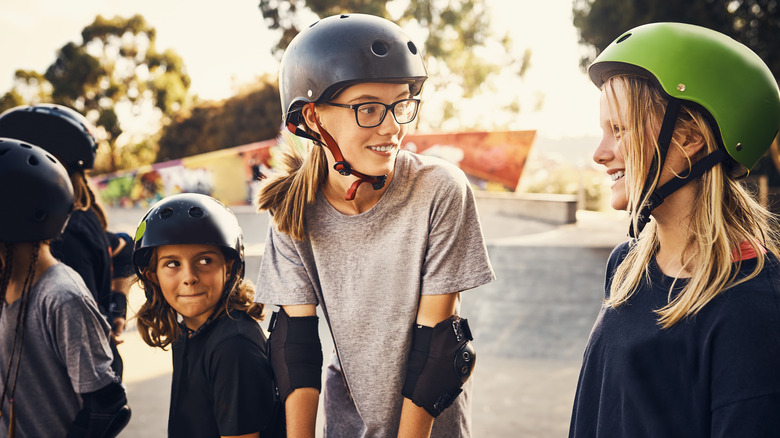Trust Us, Skateboarding Is The Coolest Way To Exercise (& Has Some Major Benefits)
Pilates, yoga, weightlifting, hot girls walks – these are all great ways to work out. But have you ever thought about skateboarding as a form of exercise? Though some skaters make it look effortless, skateboarding is actually a full-body workout that requires lots of practice and patience. Just like roller skating, skateboarding is a fun way to get around and get your body moving this summer.
Maybe skateboarding was a hobby you explored as a kid and later gave it up. Well, it's never too late to try again. In fact, there are people on TikTok learning to skate in their 30s, and there's a hashtag called #skatersover50 with over a million views. You don't necessarily have to learn all the fancy tricks like Tony Hawk; even just cruising on a longboard will have you breaking a sweat and testing your balance. Let's take a look at the benefits that come with skateboarding, along with looking cool, of course. But please, don't forget to wear a helmet and pads for your elbows and knees.
It improves balance and coordination
Balance is a key component of skateboarding. When you have a strong sense of balance, this improves both stability and mobility in everyday life, like walking, being able to pick something off the ground, stepping over obstacles, and other athletic activities. Skateboarding in itself can be a form of balance training to strengthen the muscles that keep you mobile and stable. When skaters first get on a board, it's often a little scary and wobbly at first. It helps to have someone around to help you balance until you feel comfortable, or you can lean against a wall while practicing getting on the board.
Skating also requires a high level of focus and coordination. It's all about knowing how to move your body in certain directions. To propel yourself forward on a skateboard, you balance on one leg and use the other leg to push off the ground. You then have to plant both feet on the board and lean forward to prevent yourself from falling back. To turn left or right, you shift your weight between your heels and your toes. As you get to more advanced skating like learning tricks, skateboarding requires you to think quickly on your feet to execute the trick and land on your feet successfully. With lots of practice, you'll get more comfortable balancing on the board and you might notice your overall stability and coordination improve over time.
It builds core and glute strength
Balance goes hand in hand with core strength, as a strong core helps us balance in the first place. The core includes the abdominal muscles as well as the muscles around your hips and spine. These muscles work hard when doing tricks or balancing down steep hills, as all of your core muscles are engaged in order to keep you stabilized and upright. The more you ride and practice, you may notice how strong your core has become after all that hard work.
Believe it or not, the gluteus maximus (that's right — your behind) is also important for skateboarding. This muscle helps you maintain balance as you go from a crouched to an upright position as you're maneuvering on the board. As you push off the ground and extend your foot back, this engages your glutes. You perform a similar motion when using the kickback machine at the gym, which also works out these muscles.
It's a leg workout
You might notice how, after a skating session, it feels like you just did leg day at the gym. That's because skateboarding utilizes just about all of your leg muscles. "When you are kicking and pushing to move forward, you use your quads, hamstrings, calves, and glutes," certified personal trainer Marshall Weber tells Bustle.
The quadriceps and hamstrings are engaged as you extend your knees as well as crouch on the board for long periods of time. You'll especially feel your quads when you're pushing up a steep hill. Your calves are utilized as you shift your weight while turning, leaning back on your heels, and pointing your toes down. Skating is all about repetitive motion, which will definitely give your legs a workout.
Learning tricks will build up your legs as well. Let's take the ollie, for instance. This is typically one of the first tricks skateboarders learn. This involves crouching down and pushing off the board with both feet to bring yourself in the air and then landing back down on the board, per skate enthusiasts at Sted Skater.
Try skateboarding for cardio
Running doesn't have to be the only cardio you do, and not everyone's a fan of it. Sick of the treadmill? Go for a ride on a skateboard or longboard. It'll get your heart pumping and have you breaking a sweat. In order to pick up speed on a skateboard, you have to continuously push off the ground with your foot to propel yourself forward. According to exercise science professor Michele Olson, Ph.D., doing this can "accelerate your cardiovascular system and burn between eight and an impressive 12 calories per minute," she says via Men's Journal.
This is not to say that skateboarding can completely replace cardio, as in the beginning stages, your main focus will be balancing on the board. But over time, as you're able to move more quickly on the board and navigate hilly terrain, skateboarding can become a great way to work the cardiovascular system and give your heart some love.
It also has mental health benefits
Like many other sports, skateboarding has both physical and mental health benefits. In a 2019 study from the University of Southern California, researchers surveyed over 5,000 skateboarders between the ages of 13 and 25 from around the United States. One of the key findings was how skateboarding can improve mental health. When asked about why they skated, a majority of the skateboarders reported that they did it to "have fun" and "get away from stress." After a hard day, cruising on your board might help to take your mind off things for a while.
Skateboarding is a sport that also requires tremendous patience and resilience. People aren't great at it right away; it involves a lot of falling and getting back up to try again. When the skateboarders in the study were asked about the skills they believed they had, a majority of them responded that they can "stick with a challenge," "think outside the box," and "solve tricky problems." One of the participants, a 24-year-old skateboarder explained, "...I just really respect the fact that it's taught me that things aren't going to happen first try, and if they do, it's a rare occurrence. What really determines the difference between you and the next person is your willingness to suffer through the necessity of the process in order for you to reach a goal..." Skateboarding teaches you resilience that applies to your life overall, allowing you to think quickly on your feet and overcome tough obstacles.
Skating builds relationships
Along with stress relief and resilience, the USC study also highlighted the ways skateboarding brings people together to share a common love for the sport. When asked what they liked best about their local skatepark, a majority of the skateboarders chose answers related to people: "I can meet my friends there," "The people skating there," and "It's a safe place for me." Skateboarding offers an opportunity to learn from one another, with the pros passing down their knowledge to the rookies.
If you and your friends are looking for a new hobby to try together, try heading to your local skatepark. You might meet some new people who are just as excited about skateboarding. And remember, skateboarding is not just for the guys. Certain identities, especially women, have been historically excluded from the sport. This has inspired people to create organizations that create inclusive communities for young women who want to skateboard, including Skate Like a Girl. This non-profit organization hosts youth and adult skate camps, youth outreach, community meetups, and events on the West Coast in cities like Seattle, Portland, and the San Francisco Bay Area. According to their 2022 annual report, 90% of participants report that Skate Like a Girl created a safe space physically, socially, and emotionally. There might be similar programs near you, or you can create your own.
